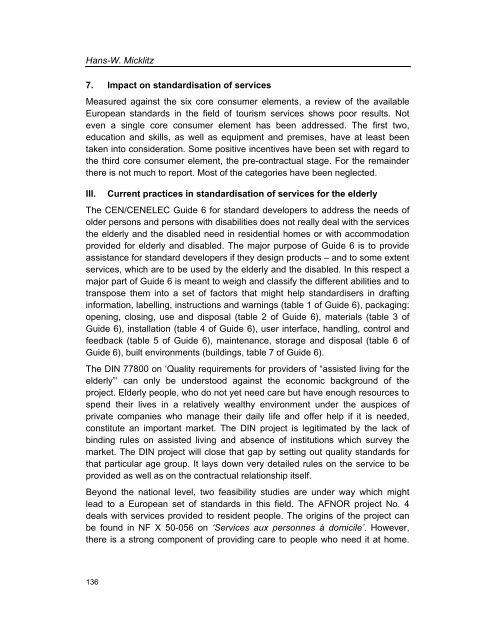Services Standards: Defining the Core Consumer Elements ... - ANEC
Services Standards: Defining the Core Consumer Elements ... - ANEC
Services Standards: Defining the Core Consumer Elements ... - ANEC
Create successful ePaper yourself
Turn your PDF publications into a flip-book with our unique Google optimized e-Paper software.
Hans-W. Micklitz<br />
7. Impact on standardisation of services<br />
Measured against <strong>the</strong> six core consumer elements, a review of <strong>the</strong> available<br />
European standards in <strong>the</strong> field of tourism services shows poor results. Not<br />
even a single core consumer element has been addressed. The first two,<br />
education and skills, as well as equipment and premises, have at least been<br />
taken into consideration. Some positive incentives have been set with regard to<br />
<strong>the</strong> third core consumer element, <strong>the</strong> pre-contractual stage. For <strong>the</strong> remainder<br />
<strong>the</strong>re is not much to report. Most of <strong>the</strong> categories have been neglected.<br />
III.<br />
Current practices in standardisation of services for <strong>the</strong> elderly<br />
The CEN/CENELEC Guide 6 for standard developers to address <strong>the</strong> needs of<br />
older persons and persons with disabilities does not really deal with <strong>the</strong> services<br />
<strong>the</strong> elderly and <strong>the</strong> disabled need in residential homes or with accommodation<br />
provided for elderly and disabled. The major purpose of Guide 6 is to provide<br />
assistance for standard developers if <strong>the</strong>y design products – and to some extent<br />
services, which are to be used by <strong>the</strong> elderly and <strong>the</strong> disabled. In this respect a<br />
major part of Guide 6 is meant to weigh and classify <strong>the</strong> different abilities and to<br />
transpose <strong>the</strong>m into a set of factors that might help standardisers in drafting<br />
information, labelling, instructions and warnings (table 1 of Guide 6), packaging:<br />
opening, closing, use and disposal (table 2 of Guide 6), materials (table 3 of<br />
Guide 6), installation (table 4 of Guide 6), user interface, handling, control and<br />
feedback (table 5 of Guide 6), maintenance, storage and disposal (table 6 of<br />
Guide 6), built environments (buildings, table 7 of Guide 6).<br />
The DIN 77800 on ‘Quality requirements for providers of “assisted living for <strong>the</strong><br />
elderly”’ can only be understood against <strong>the</strong> economic background of <strong>the</strong><br />
project. Elderly people, who do not yet need care but have enough resources to<br />
spend <strong>the</strong>ir lives in a relatively wealthy environment under <strong>the</strong> auspices of<br />
private companies who manage <strong>the</strong>ir daily life and offer help if it is needed,<br />
constitute an important market. The DIN project is legitimated by <strong>the</strong> lack of<br />
binding rules on assisted living and absence of institutions which survey <strong>the</strong><br />
market. The DIN project will close that gap by setting out quality standards for<br />
that particular age group. It lays down very detailed rules on <strong>the</strong> service to be<br />
provided as well as on <strong>the</strong> contractual relationship itself.<br />
Beyond <strong>the</strong> national level, two feasibility studies are under way which might<br />
lead to a European set of standards in this field. The AFNOR project No. 4<br />
deals with services provided to resident people. The origins of <strong>the</strong> project can<br />
be found in NF X 50-056 on ‘<strong>Services</strong> aux personnes à domicile’. However,<br />
<strong>the</strong>re is a strong component of providing care to people who need it at home.<br />
136
















